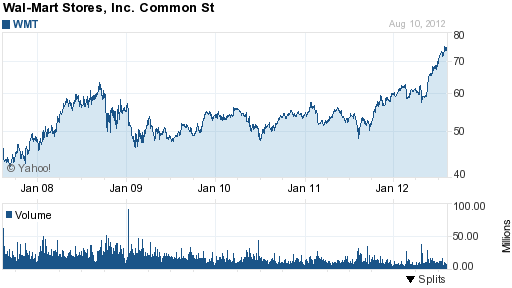Continuing some large-cap cursory scanning, I notice that Amazon is still at its very lofty valuation – I have no idea why they are trading so highly, but then again, that’s been the case for quite some time.
Whenever I look at Amazon I instinctively punch in Walmart. They have been in a trading range for most of last decade, but interestingly enough, they’ve appeared to have broken out of their trading range:
Back in the early 2000′s, Walmart was trading a very healthy P/E (around 20-25) and they had to settle into their valuation by actually earning enough in earnings to warrant the price. A few years ago they were around the 10-11 future-looking P/E range, while now they have crept up to 14 times future earnings. Is this because capital that was otherwise earmarked toward fixed income investments has moved into the equity side? Walmart equity is as close to a GDP-linked bond-like instrument as you could have gotten in the large cap market and I am wondering if others are seeing it this way?
Walmart is pretty much the economic barometer of the US retail economy and the other explanation is that maybe the US economy is recovering or stronger than the media makes it out to be?
I also notice that Target has exhibited a similar boost this year, albeit somewhat less pronounced than Walmart.
